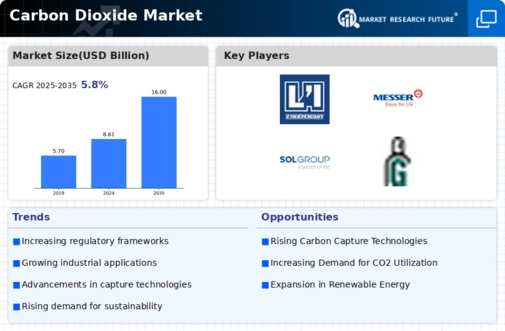Major market players are spending a lot of money on R&D to increase their product lines, which will help the Carbon dioxide Market grow even more. Market participants are also taking a range of strategic initiatives to grow their worldwide footprint, including new product launches, contractual agreements, mergers and acquisitions, increased investments, and collaboration with other organizations. Competitors in the Carbon dioxide Market industry must offer cost-effective products to expand and survive in an increasingly competitive and rising market environment.
One of the primary business strategies adopted by manufacturers in the global carbon dioxide industry to benefit clients and expand the Carbon dioxide market sector is partnerships and acquisitions. The market for Carbon dioxide is recognized as being extremely competitive and fragmented. The market for Carbon dioxide offers considerable potential opportunities for domestic and unorganized companies.
Some of the key players operating in the market include Air Liquide (France), Linde (Ireland), Air Products and Chemicals (US), Messer Group (Germany), Sicgil India Ltd (India), Acail (Portugal), Taiyyo Nippon Sanso Corporation (Japan), SOL Group (Italy), India Glycols Ltd (India), and Greco Gas (US). To increase their global reach and client base, key firms are concentrating on acquisitions and product innovation.
Greco Gas Inc.: Greco Gas Inc. specializes in the business of specialty & industrial gases, bulk propane, filler metals, welding equipment & supplies and safety equipment. The company offers industrial, microbulk and specialty gases that fulfill numerous gas requirements in various industries. Some of the industrial gases provided by the company include oxygen, argon, helium, carbon dioxide and hydrogen. Its specialty gases category includes medical gas, beverage gas, lase gas mixtures, custom gas mixtures, and high purity gases.
The industries served by the company through its wide variety of products and services include manufacturing, welding, metal fabrication, food & beverage, construction, power & energy, agriculture and healthcare & life sciences, among others. The company produces carbon dioxide of various grades such as industrial, food and beverage and coleman grades for serving purposes in welding, beverage industry and fuel tank and pipeline applications.
India Glycols Limited: India Glycols Limited specializes in the manufacturing of bulk, specialty and performance chemicals, natural gums, industrial gases, sugar, spirits and nutraceuticals. The chemical division of the company is further categorized as ethylene glycols (MEG, DEG and TEG), ethoxylates and polyethylene glycols (PEG), glycol ethers and acetates and performance chemicals. The products manufactured by the company find applications in industries such as automotive, mining, oil & gas, paper, pharmaceuticals, personal care, food processing and many more. It has two plants of beverage grade liquid CO2 at Gorakhpur and Kashipur units.
The company invests significantly on enhancing its research and development capabilities. The R& D division of the company focuses on scaling up the quality and processes along with reducing the overall cost. The facilities of the company are certified and approved by international agencies such as Det Norske Veritas (DNV).















Leave a Comment